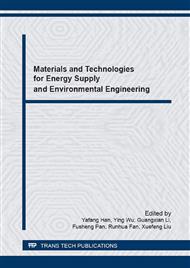[1]
Nešić S. Key issues related to modelling of internal corrosion of oil and gas pipelines–A review. Corros. Sci. 12 (2007) 4308-4338.
DOI: 10.1016/j.corsci.2007.06.006
Google Scholar
[2]
R.D. Kane, M.S. Cayard, NACE Committee Report 8X294: Review of Published Literature on Wet H2S Cracking, NACE Corrosion/99, San Antonio, TX, (1999).
Google Scholar
[3]
W.K. Kim, H.G. Jung, G.T. Park, S.U. Koh, K.Y. Kim, Relationship between hydrogen-induced cracking and type I sulfide stress cracking of high-strength linepipe steel. Scripta Mater. 62 (2010) 195-198.
DOI: 10.1016/j.scriptamat.2009.10.028
Google Scholar
[4]
M.V. Biezma, The role of hydrogen in microbiologically influenced corrosion and stress corrosion cracking, Int. J. Hydrogen Energy 26 (2001) 515–520.
DOI: 10.1016/s0360-3199(00)00091-4
Google Scholar
[5]
T.P. Gyu, U.K. Sung, G.J. Hwan, Y.K. Kyoo, Effect of microstructure on the hydrogen trapping efficiency and hydrogen induced cracking of linepipe steel, Corros. Sci. 50 (2008) 1865–1871.
DOI: 10.1016/j.corsci.2008.03.007
Google Scholar
[6]
Y.F. Chen, Analysis of electrochemical hydrogen permeation through X-65 pipeline steel and its implications on pipeline stress corrosion cracking, Int.J. Hydrogen Energy 32 (2007) 1269–1276.
DOI: 10.1016/j.ijhydene.2006.07.018
Google Scholar
[7]
B.F.M. Pots, R.C. John. Improvement on De Waard-Milliams corrosion prediction and application to corrosion management. Corrosion/2002. Houston: NACE, 2002: 02235.
Google Scholar
[8]
J. Kvarekval, R. Nyborg, M. Seiesten. Corrosion product films on carbon steel in semi-sour CO2/ H2S environments. Corrosion /2002. Houston: NACE, 2002: 02296.
Google Scholar
[9]
C. Plennevaux , J. Kittel, M. Frégonèse, B. Normand, F. Ropital, F. Grosjean, T. Cassagne. Contribution of CO2 on hydrogen evolution and hydrogen permeation in low alloy steels exposed to H2S environment. Electrochemistry Communications 26 (2013).
DOI: 10.1016/j.elecom.2012.10.010
Google Scholar
[10]
J. Kittel, F. Ropital, J. Pellier, Effect of Membrane Thickness on Hydrogen Permeation in Steels During Wet Hydrogen Sulfide Exposure. Corrosion 64 (2008) 788–799.
DOI: 10.5006/1.3278446
Google Scholar
[11]
C.S. Zhou, S.Q. Zheng, C.F. Chen, G.W. Lu, The effect of the partial pressure of H2S on the permeation of hydrogen in low carbon pipeline steel, Corros. Sci. 67 (2013) 184–192.
DOI: 10.1016/j.corsci.2012.10.016
Google Scholar
[12]
C. Zhou, X. Chen, Z. Wang, S. Zheng, X. Li, L. Zhang, Effects of environmental conditions on hydrogen permeation of X52 pipeline steel exposed to high H2S-containing solutions. Corros. Sci. 89 (2014) 30-37.
DOI: 10.1016/j.corsci.2014.07.061
Google Scholar
[13]
JIS, Method for Measurement of Hydrogen Evolved from Deposited Metal, Japan, (1975).
Google Scholar
[14]
S.Q. Zheng, Y.M. Qi, C.F. Chen, S.Y. Li, Effect of hydrogen and inclusions on the tensile properties and fracture behaviour of A350LF2 steels after exposure to wet H2S environments, Corros. Sci. 60 (2012) 59–68.
DOI: 10.1016/j.corsci.2012.04.012
Google Scholar
[15]
ASTM Standard G31, Practice for Laboratory immersion corrosion testing of metals. ASTM International.
Google Scholar
[16]
ISO 8407, Corrosion of metals and alloys-removal of corrosion products from corrosion test specimens. International Standardization Organization.
DOI: 10.3403/30346599
Google Scholar
[17]
P.P. Bai, S.Q. Zheng, H. Zhao, Y. Ding, J. Wu, C.F. Chen, Investigations of the diverse corrosion products on steel in a hydrogen sulfide environment, Corros. Sci. 87 (2014) 397–406.
DOI: 10.1016/j.corsci.2014.06.048
Google Scholar
[18]
P.P. Bai, S.Q. Zheng, H. Zhao, Y. Ding, J. Wu, C.F. Chen, Investigations of the diverse corrosion products on steel in a hydrogen sulfide environment, Corros. Sci. 87 (2014) 397–406.
DOI: 10.1016/j.corsci.2014.06.048
Google Scholar
[19]
G. Zhang, C. Chen, M. Lu, C. Chai, Y. Wu. Evaluation of inhibition efficiency of an imidazoline derivative in CO2-containing aqueous solution. Materi. Chem. Phys. 105 (2007) 331–340.
DOI: 10.1016/j.matchemphys.2007.04.076
Google Scholar


